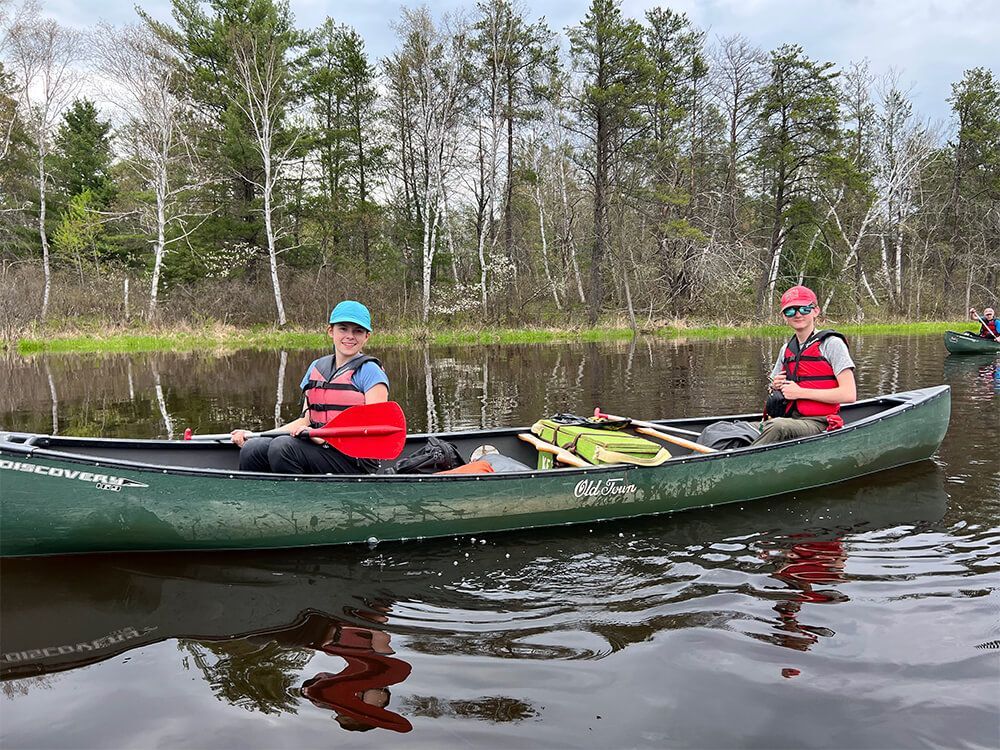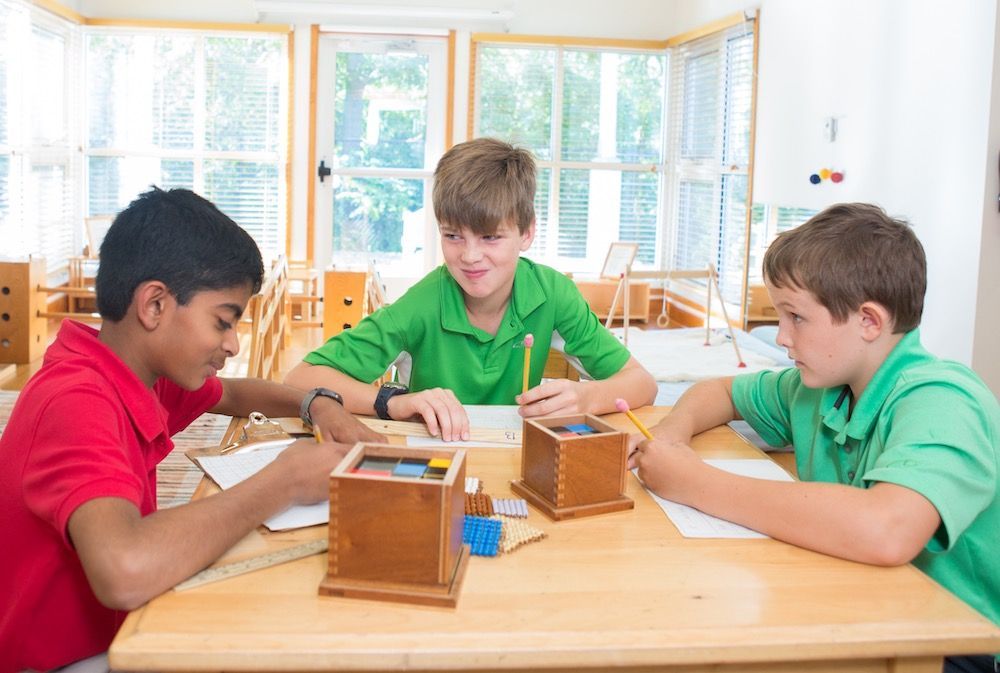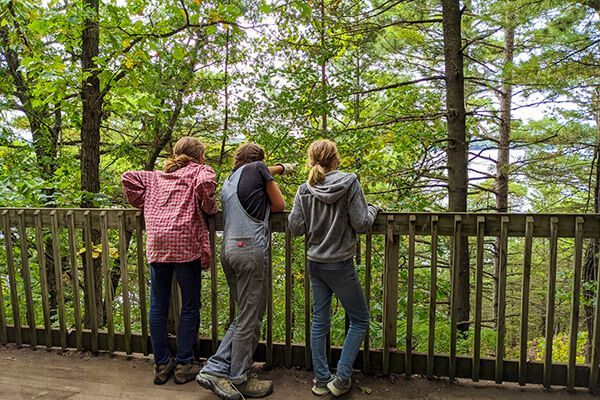
We are immensely grateful that this fall, our Secondary Level adolescents were able to go off into the woods to get away from screens, the media, and the consuming concerns of the adult world for two full weeks. Camping trips offer people the chance to bond with one another, to re-set their nervous systems and to connect with the grounding rhythms of nature. This is more important in adolescence than perhaps at any other time in our children’s development, especially in our current times.
Such results cannot be achieved in the same ways between classroom walls during the years of early adulthood. People need to be actively working together interdependently to become contributing members of any community, and to develop themselves fully. In fact, Dr. Maria Montessori believed, “To act in association with others either in thought or in practice is the only way in which human nature can be active…Education cannot be kept within the limits of a closed room in which the student remains inert and always dependent upon the teacher while being kept separate from his fellow students…Education must be to offer a wider environment and to multiply the possibilities of association and activity” (From Childhood to Adolescence). Important parts of our children’s development happen when they experience living away, even for brief periods, out in the world.
Dr. Montessori pointed out that adolescence, in particular, is a vulnerable time of rapid growth and sensitivity. This is also a period of inconsistency, where adolescents seem to be up then down in the span of an hour, exhibiting superhero strength one minute and feeling exhausted the next, full of cheer one minute, then sobbing in despair the next. Living through this transitive stage of life is much like a roller coaster for them and for the adults around them!
To support our Secondary Level students through these inner challenges and to give them opportunities for healthy, positive growth in substantial areas of their development, Forest Bluff School helps them to plan three work service camping trips a year. Providing such an opportunity to live out in nature and to work together as a community is more important for the next generation than ever before. But to prepare themselves to understand and solve the problems of the natural world, young adults first must have a passion for it. They need to understand, on a visceral level, how to work with and in natural surroundings. And they must understand, and have experience, living in unison with others. To seek out and be able to work in community with others, our young adults need to have a passion to do so. Adolescents fall in love with nature and with community life by experiencing it, especially in this tender stage of their lives. Thus, our Secondary Level trips have two special elements—nature and community—that give these budding young adults purpose and focus.

Learning to Love Nature
Montessori education capitalizes on the relationship between human beings and nature from the very beginning; in early childhood, children develop a connection with nature by experiencing it sensorially and fall in love with it. The natural world becomes their home. They come to respect the natural world in a physical way, as we see when our youngest children learn to tenderly wash the leaves of a houseplant in the Young Children’s Community and Primary classrooms.
In their elementary years, Montessori children learn to respect the natural world in an intellectual way, learning about photosynthesis and the interdependencies in nature. They are awed by the miracles of creation and evolution. Using their imaginative powers, children personify plants and animals to recognize what their purposes and motivations are.
Now in early adolescence, Montessori children learn to respect nature on an emotional level, where they can understand that we need the natural world and it benefits from us as well. They come to realize and feel, “The natural world heals me, and I can physically help the natural ecosystems around me. I belong here, I am part of it, and it is a part of me.” Living outdoors in nature on camping trips helps them to feel this deeply.
In later adolescence, young adults will be ready to take that respect, love, and sense of belonging and connection and turn it into a bigger mission. High school students can see that we are all interwoven and each has a job to do; they are ready to internalize this intellectually. They realize that humanity and nature work together. If they have had all this preparation leading up to it, then by university, our children are ready to help others understand this. They want to affect the world and make a change—make a difference. It is important not to expect this level of maturity in childhood or early adolescence, but to allow each stage to fully develop on this path. Adulthood is a point of arrival. All of this grows out of that first seed of love for the natural world.
As examples of these experiences, our students saw beautiful, natural sights on this last fall trip. They saw juvenile eagles and osprey catching the air currents off the bluff where they were camping and working. They saw the leaves turn yellow and fall off the trees. They lay outside on the ground gazing up at the stars at night and learned names of constellations from one another. In such ways, nature supported the children and inspired them. Such peaceful moments in natural surroundings builds that deep love for our environment and a timeless concern for it.
Learning to Love Community
Like the importance of developing a sincere love for nature, it is immensely important that our children develop love for humanity in order to become a part of it. From that love comes a burning passion to help others and to devote themselves to society. Montessori pointed out that the young adult cannot, “take part in the functioning of a society for which he lacks all feeling” (From Childhood to Adolescence). So, it is imperative that in this time when COVID causes greater isolation from one another, our young adults experience real community life.
Every evening on the fall trip, the Secondary Level students made a campfire. They sat around it out under the stars and shared what went well that day and what they thought they could do better the next day. They also thanked one another for what each had done for the group. In these ways, our adolescents cultivate a proactive attitude towards solving problems and a daily habit of expressing gratitude. Some of the most common “thank yous” mentioned were for: patience for a classmate, volunteering for a task, persevering to finish a hard task together. There were also many funny moments to recollect every day. Over the course of the trip, there was a lot of laughing, playing outdoor games, and singing together.
Living in community supports adolescents. They develop a fondness for one other, they laugh hard together, and they help one another. For example, we heard that on this last trip, one boy observantly helped a girl who was struggling to figure out the sequence of cleaning the dishes, (made more complex with COVID safety guidelines). Adults later remarked at how he patiently, calmly, kindly talked her through it and made suggestions. Such interactions build a deep trust between individuals. Adolescents get to grow from such experiences, and they bond in a friendship more like family members than classmates.
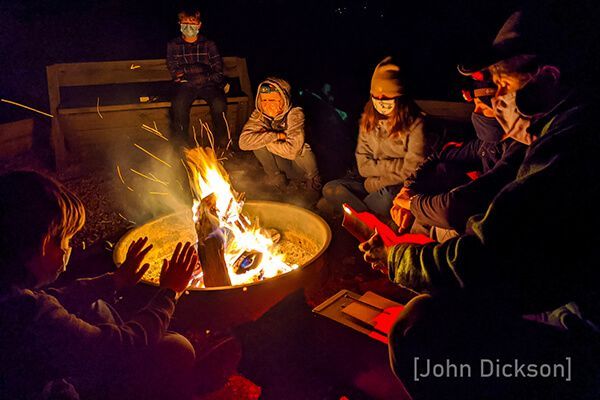
Being Challenged to Grow Strong
Adolescents are supported by the natural world and by living in community, but they are also deeply challenged by these two factors. Nature, for instance, challenges our students in many ways: it can be very cold at night and in the mornings, and on this last trip, there was more than one cold, rainy morning of trying to cook and eat breakfast outside. There are spiders that can find their way into tents, causing unexpected irritation and fear. Living out in nature 24/7 is uncomfortable and requires campers to adjust by making changes to their attire and ways of doing things, in order to get comfortable.
Living in community also challenges adolescents. They have to work with each other all the time. When they are tired, they may want to put down their shovels and walk back to the tents to rest. But if the work isn’t done yet, that isn’t an option if they want to stay part of the group. They each must persist through personal discomfort. When they are cooking and cleaning up, students have to collaborate, even with personalities who see things differently. They have to fine tune their systems of working together until they can make progress without conflict. They develop their own substantial rhythm.
These numerous social interactions pose challenges to grow from. Young adults get better and better at navigating through community life on a camping trip, where common tasks must be done and there’s no escape. A student cannot just go off on his or her own; each is forced to work together and figure it out as a community. Each person’s well-being depends on it. Adolescents are incredibly capable; in fact, as they mature, we even see them serve themselves last, after preparing food for others.
Every new situation when living in nature and in community challenges young adults to grow in meaningful ways and prepares them for adulthood. Perhaps just as importantly, the Secondary Level trips foster a deep love for nature and community that will shape how our young people approach life when they become adults.
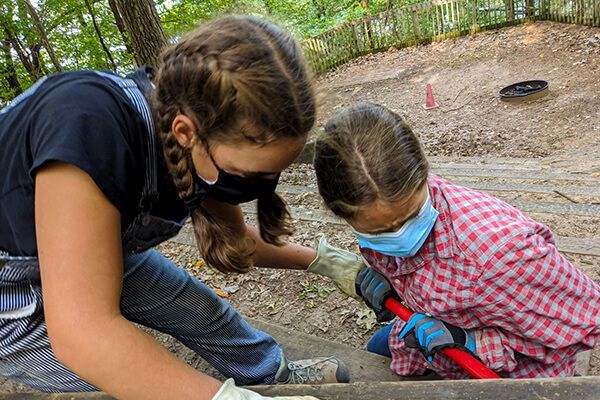
Doing Hard Work
Over the two weeks of the fall trip, our Secondary Level students threw themselves into physical tasks of service work. They cleared buckthorn, shoveled trenches to re-rout water, cleaned up an outdoor camp chapel, and laid grass seed. They replaced rotted fence posts and beams, dug holes for signposts, reorganized a utility building, cleared out a barn attic, painted an old barn, and fixed wire fencing. The eleven adolescents accomplished an amazing amount of physical work in just 12 days. They felt good about it! This was hard work that involved trekking up and down steep hills numerous times a day, in the heat, and pushing themselves. It was very demanding and, therefore, deeply satisfying.
The Secondary Level Directors who lived with the students on this recent trip said, “It’s just magical up there.” They were referring to more than just the physical beauty of the rural St. Croix region of Wisconsin, however: It was the relationships the class formed in that setting that made the trip so profound. The adolescents developed their relationships through hard work, and they returned home to school as a family.
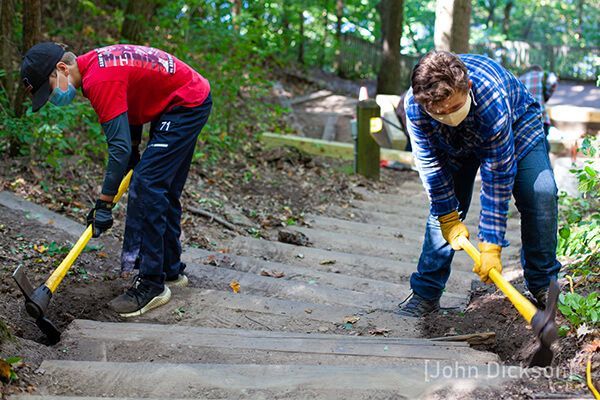
When Adolescents Return Home
When preparing Forest Bluff parents to welcome their adolescents home after the two weeks away, we remind them that the purpose of the trips was to introduce some challenges into their children’s lives so that they could build emotional strength. Overcoming reasonable challenges helps children develop self-esteem and confidence. This is key during this more turbulent stage of life. Inevitably, our Secondary students come home needing to share stories of their personal struggles with their parents. Sometimes the first stories parents hear may be the ones involving the hardest moments! What adolescents need in return is validation and sincere admiration from the adults around them.
Parents can validate their children by responding with respect, by commenting on how the stories prove that their children have become so strong and capable. The adolescents–with their stories of struggles and triumphs–are just trying to convey, “I was deeply challenged; this wasn’t so easy for me.” They need their parents’ response to be, “And I’m so proud of you; you did it on your own, without me there to protect you or tell you what to do. You did it!” Going off on a two-week trip is about developing independence at an age when young adults need to know they will be able to survive life without their parents always present. With their peers and adult mentors there to support them, our students find that they can accomplish many difficult tasks in life. They come home taller and prouder.
Following a Secondary Level trip, we also introduce the idea to parents that when their child re-enters the family, the dynamic of child and parents may shift a bit. This is a wonderful opportunity! When they return from the fall trip, it is a great time to invite adolescents to take on more adult-like roles in their families. We encourage parents to treat their adolescents as being more capable than when they left. Not only can young adults take care themselves, they can care for their parents and siblings a bit, too. Parents may do some nice things for their adolescents, but adolescents can also step up and do some things for the other adults in the house, as well. Doing such things as planning and cooking a dinner, cleaning up the garage, painting the basement, or doing another adult-like project valorizes young adults. It helps them to feel strong and to find their sense of self-worth. They can bring some of that newfound strength into their lives at home.
By talking about the purpose of the trips in this way, we prepare parents to welcome the young person who steps into their car after a Secondary Level trip as the new being that they are: a little less of a child and a bit more of an adult. This gradual transition is the magic of adolescence, a special stage of life.
How Adolescents Prepare for Today's World
When the world seems to be taken over by fears of the novel coronavirus, climate change, pollution, societal strife, racial struggles, and political tension, it is important to be reminded that there are reasons to hope. There are ways to calm ourselves and think more clearly and creatively. There are simpler, more basic ways of living that we can find in community life in natural settings. Getting back in touch with this foundation presents young people with the basic structures of society and the ways to resolve problems. By tackling the small problems that arise naturally, one at a time, on a work trip, adolescents build up practice cooperating and solving problems as a community. This prepares them for the real world and the bigger challenges they will face in their lives.
These trips are invaluable to our young adults. We are very proud and grateful that we were able to help our young adults to make adjustments and accommodations for new safety requirements in COVID times, so that they could still carry on with certain life priorities. Our Secondary Level students learned that it is possible to adapt to the times and to continue with this important aspect of their Forest Bluff education, even when, and especially when, faced with big challenges.
